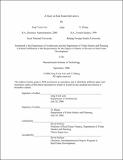| dc.contributor.advisor | David Geltner. | en_US |
| dc.contributor.author | Lim, Jong Yoon, S.M. Massachusetts Institute of Technology | en_US |
| dc.contributor.author | Zhang, Yi | en_US |
| dc.contributor.other | Massachusetts Institute of Technology. Dept. of Architecture. | en_US |
| dc.date.accessioned | 2007-06-27T20:27:16Z | |
| dc.date.available | 2007-06-27T20:27:16Z | |
| dc.date.copyright | 2006 | en_US |
| dc.date.issued | 2006 | en_US |
| dc.identifier.uri | http://dspace.mit.edu/handle/1721.1/37444 | en_US |
| dc.identifier.uri | http://hdl.handle.net/1721.1/37444 | |
| dc.description | Thesis (S.M.)--Massachusetts Institute of Technology, Dept. of Architecture, 2006. | en_US |
| dc.description | This electronic version was submitted by the student author. The certified thesis is available in the Institute Archives and Special Collections. | en_US |
| dc.description | Includes bibliographical references (leaves 85-86). | en_US |
| dc.description.abstract | All major asset classes including stocks and bonds have a well developed derivative market. Derivatives enable counterparties to reflect a view on a particular market, without having to trade the underlying asset. This seems to be a particularly appealing feature for real estate, an industry characterized by high transaction cost, long lead transaction time and lack of short-selling mechanism. Still, real estate remains the last major asset class without a liquid derivative market until recently when Credit Suisse began to offer swaps on the NCREIF Property Index (NPI) in the U.S. early this year following the UK's ten-year endeavor in developing real estate derivative market. The purpose of this thesis is two fold. First, in chapter one and two, we would like to explain what real estate derivatives are, how they work and why they can be beneficial to investors. Second, we are introducing some practical tools investors may use in evaluating and trading real estate derivatives. In chapter three, we are introducing three forecasting models on the NCREIF Property Index. In chapter four, we are expanding Prof. David Geltner's pricing methods on real estate index capital return swap to the NPI total return swap and property type total return swap. | en_US |
| dc.description.abstract | (cont.) These pricing methods present a basic foundation for investors to price all three types of swap currently being offered by Credit Suisse. In our study, we find that derivatives can provide numerous benefits to real estate investors including low transaction cost, quick execution and short-selling mechanism. These benefits in turn can help investors implement various strategies including hedging against market risk, asset allocation, sector rebalancing, international diversification and portable Alpha. Our research on UK's experience in real estate derivatives as well as our investor survey results in the U.S. and the UK lead us to believe that further initiative and pioneering efforts are critical for the development of the real estate derivatives market. By presenting this study on index forecasting models and pricing methodologies, we hope to increase the awareness and comfort level of investors and thus encourage the proliferation of real estate derivatives. | en_US |
| dc.description.statementofresponsibility | by Jong Yoon Lim and Yi Zhang. | en_US |
| dc.format.extent | 100 leaves | en_US |
| dc.language.iso | eng | en_US |
| dc.publisher | Massachusetts Institute of Technology | en_US |
| dc.rights | M.I.T. theses are protected by copyright. They may be viewed from this source for any purpose, but reproduction or distribution in any format is prohibited without written permission. See provided URL for inquiries about permission. | en_US |
| dc.rights.uri | http://dspace.mit.edu/handle/1721.1/37444 | en_US |
| dc.rights.uri | http://dspace.mit.edu/handle/1721.1/7582 | |
| dc.subject | Architecture. | en_US |
| dc.title | A study on real estate derivatives | en_US |
| dc.type | Thesis | en_US |
| dc.description.degree | S.M. | en_US |
| dc.contributor.department | Massachusetts Institute of Technology. Department of Architecture | |
| dc.identifier.oclc | 123441650 | en_US |
